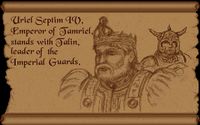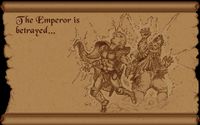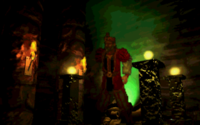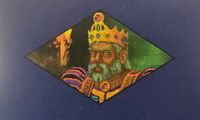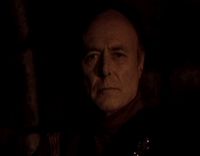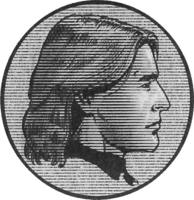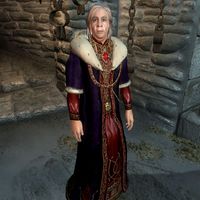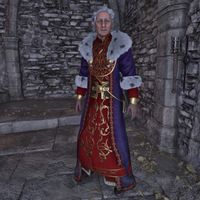Lore:Uriel VII
| Emperor Uriel Septim VII | |||
|---|---|---|---|
 Emperor Uriel Septim VII ruminating in his final hours Emperor Uriel Septim VII ruminating in his final hours
|
|||
| Race | Imperial | Gender | Male |
| Born | 3E 346 |
||
| Died | 3E 433 Imperial City Prison |
||
| Resided in | Imperial City | ||
| Appears in | Arena, Daggerfall, Oblivion, Oblivion Mobile, Legends | ||
| Emperor of Tamriel | |||
| Reign | 3E 368- 3E 389 |
||
| Previous Ruler | Pelagius Septim IV | ||
| Next Ruler | Jagar Tharn | ||
| Emperor of Tamriel (Restored) | |||
| Reign | 3E 399- 3E 433 |
||
| Previous Ruler | Jagar Tharn | ||
| Next Ruler | Martin Septim | ||
The skies are marked with numberless sparks, each a fire, and every one a sign. —Uriel Septim VII, the Emperor of Tamriel
Uriel Septim VII (/ˈjʊəriəlˈsɛptɪm/ yer-iel septm⏵) was the twenty-first Dragonborn Emperor of the Third Empire and the Septim Dynasty,[1][2][3]:3 though some described him as the twenty-fourth of the Septim line.[4][nb 1] He succeeded to the throne in 3E 368 after the passing of his father, Pelagius Septim IV. Uriel VII's 65-year reign was interrupted for a decade by the Imperial Simulacrum, during which he was trapped in another plane of existence while the impostor Jagar Tharn ruled in his name.[2] After being restored to the throne, his reign saw the Miracle of Peace in High Rock and the fulfillment of the Nerevarine Prophecy in Morrowind.[5][6] Uriel VII was assassinated in the Imperial City in 3E 433, ushering in the Oblivion Crisis.[2][7]
While the inheritance of the Dragon Blood is not strictly based upon bloodlines,[8][UOL 1][UOL 2] Uriel's birthright was such that he could don the Amulet of Kings.[UOL 2] And it is said that the Dragon Blood which flowed through the veins of the Septims allowed them to "see more than lesser men", and only a true heir of the Blood could wear the Amulet.[9]
During his rule Uriel VII wed Princess Caula Voria, and sired at least four legitimate heirs: Ariella, Geldall, Enman and Ebel; though other direct sources indicate sons of his with other names exist: Pelagius, Cephorus, Uriel, Cassynder, Voragiel, and Trabbatus.[10][11][12][nb 2] Uriel VII fathered at least two children outside of wedlock: Calaxes (who was publicly acknowledged and participated in family affairs) and Martin (whose true lineage was hidden, even to him, until the Oblivion Crisis).[13][7] Additional unknown family members were around during this time,[12] and Uriel was said to have some nephews as well (such as Pythus Angelicus).[UOL 3][UOL 4] Regardless, when Uriel VII was assassinated, any suitable heirs known to the public were assassinated at nearly the same time, leaving only Martin to claim the Ruby Throne.[7]
Contents
Biography[edit]
Early Life[edit]
Shortly after Uriel's father, Pelagius IV, was crowned Emperor of Tamriel, Queen Barenziah and Prime Minister Symmachus of Morrowind attended a dinner with the Septim Royal Family. At that youthful age, Uriel insisted that a place be set at every meal for his imaginary female playmate, Justin. Of course, Uriel would soon grow out this. However, it would inspire a long running joke between Symmachus and Uriel throughout the monarch's reign; Symmachus would inquire into Justin's health whenever he met with the Emperor, and Uriel would respond mock-seriously on every occasion. One time Uriel elaborately explained to Symmachus that Justin had met an adventurous, though incorrigible, Khajiit youth, married him, and settled down in Lilandril to raise fire ferns and mugworts.[14]
Emperor of Tamriel[edit]
When Emperor Pelagius IV died and Uriel VII took in 3E 368 after an astonishing twenty-nine year reign, Tamriel was closer to unity than it had been since the days of Uriel I. According to historians, Uriel VII had the diligence of his grand-aunt Morihatha, the political skill of his grand-uncle Uriel VI, and the military prowess of his great-grandfather Uriel V. For sixty-five years he reigned and brought justice and order to Tamriel.[2]
Imperial Simulacrum[edit]
In 3E 389, Uriel VII was betrayed by Imperial Battlemage Jagar Tharn, who imprisoned him in an Oblivion plane of his own creation.[15][2] Tharn then used illusion magic to assume the Emperor's visage. Tharn held Uriel VII in a dimension where time ran slower, ensuring it would take centuries for him to die (at which point, the Amulet of Kings would somehow warn the Elder Council of the Emperor's passing).[16] For the next ten years, Tharn pursued his own agenda, not continuing Uriel VII's schedule of reconquest. It is not entirely known what Tharn's goals and personal accomplishments were during this time.[2]
Tharn was eventually defeated in 3E 399 by the Eternal Champion, who freed Uriel VII from his other-dimensional cell.[17] After his release, Uriel VII worked diligently to heal and reunite Tamriel. Tharn's interference broke the momentum, but the following years proved that the lauded golden age of Tiber Septim could return to Tamriel once more.
Secret Meeting[edit]
In 3E 405, Uriel VII and his new Imperial Battlemage, Ocato of Firsthold, met in the audience chamber of the Imperial Palace with an agent of the Blades. Uriel dispatched this agent to the Iliac Bay to investigate the restless ghost of King Lysandus of Daggerfall, as well as to find and destroy a letter the Emperor sent to Queen Mynisera of Daggerfall.[3][18] In 3E 417, this agent's choices would lead the many squabbling principalities of northwestern Tamriel to be magically reforged into four kingdoms. Those who celebrate the historic calm this event brought to the region remember it as the Miracle of Peace. Those who recall the massive amounts of death, destruction, and fear wrought by the event itself would more likely refer to it as the Warp in the West.[19]
Later Life[edit]
By 3E 427, Uriel VII was dogged by rumors of age and illness, and that Ocato was making the real decisions of the Empire.[20] In 3E 433, a member of the Blades wrote in a private letter that High Chancellor Ocato and the Elder Council had been running the Empire for fifteen years (i.e., since shortly after the Miracle of Peace).[21]
Uriel took considerable personal interest in the Nerevarine Prophecy of the Dunmer, and in 3E 427, he dispatched an agent of obscure origins to Vvardenfell with designs to fulfill the legend, an apparently successful venture.[15][22]
Uriel VII was troubled all his life by dreams that showed him visions of the future, including his assassination and the ensuing Oblivion Crisis.[23] On the 27th of Last Seed, 3E 433, his premonitions came to pass: his heirs were assassinated by a Daedric Cult called the Mythic Dawn during Crown Prince Geldall Septim's Engagement Ball. After midnight on the 27th, as Uriel VII was attempting to escape through the tunnels beneath the Imperial City Prison, the Mythic Dawn found and assassinated him.[11][24][UOL 5] This left only the secret son, Martin Septim, to claim the throne and save Tamriel from Oblivion.[24]
Gallery[edit]
Portrait of Uriel Septim
(Arena Deluxe Edition box art)An engraving of Uriel Septim VII
(Pocket Guide to the Empire, 3rd Edition)
Notes[edit]
-
- Additionally, some Morrowind sources (a new edit of Brief History of the Empire and the new book The Arcturian Heresy) seemingly retconned that Pelagius I was the grandson of Emperor Tiber Septim rather than being Tiber Septim's son as Daggerfall indicated. Additionally, some instances of "Tiber Septim" were changed to "Tiber Septim I"[14][26], which may have impacted the count.
- The name "Septim" as originally coined for The Elder Scroll: Arena presumably comes from the Latin "Septimus", meaning "Seventh".[LANG 1] This would mean that Uriel Septim VII means Uriel the Seventh the Seventh, and/or that "Septim" is a synonym for the Seventh.
- According to dialogue from Arena, Uriel VII's real birthday is not on the 30th of Frostfall as the holiday description for Emperor's Day implies. Instead, Emperor's Day represents a symbolic celebration of the Emperor.[27] The Arena intro implies that Uriel VII's true birthday is sometime prior to the 1st of Hearthfire (the date the game begins).[28]
- During his reign as Emperor, Uriel VII had two known secretaries. The earliest known secretary was Lomegan Mariel, who was also the Emperor's personal liaison to the Battlespire prior to its destruction.[29] The next was Glabrio Bellienus, who sent correspondence to the Blades Spymaster on Vvardenfell, Caius Cosades, about his task on the island.[22]
- The voice actor for Uriel in Arena is unknown, although Ted Peterson believes he was a local acting student. The actor for Uriel in Daggerfall was John Gilbert. The voice actor for Uriel in Oblivion was Patrick Stewart. In Oblivion Remastered, Uriel's face is more heavily modeled after Patrick Stewart's likeness.
- Lead Designer Ken Rolston had this to say about Uriel VII's portrayal in Oblivion: "[Patrick Stewart] was selling the product like a reverend... standing in front of his flock... which is exactly the tone I wanted." According to Todd Howard, Rolston had "written a bunch of notes for Patrick Stewart on the character—very, very long, referencing things Stewart had done before. I thought it was embarrassingly long, actually."[30]
- Uriel's five appearances make him tied with Staada for the character with the most appearances in the series, excepting Daedric Princes.
See Also[edit]
Books[edit]
- A Life of Uriel Septim VII by Rufus Hayn — A short biography of Uriel Septim VII's accomplishments
- Assassination! — A newspaper article on the assassination of Emperor Uriel Septim VII and his heirs
- Biography of Queen Barenziah by Stern Gamboge, Imperial Scribe — The life history of Queen Barenziah
- Brief History of the Empire by Stronach k'Thojj III — A description of events in the history of the Empire
- Guide to the Imperial City by Alessia Ottus — An overview of the Imperial City's people and notable places
- Pocket Guide to the Empire, 3rd Edition: All the Eras of Man, A Comprehensive History of our History — Imperial Geographical Society, 3E 432
- Pocket Guide to the Empire, 3rd Edition: The Seat of Sundered Kings: Cyrodiil — Imperial Geographical Society, 3E 432
- The Oblivion Crisis by Praxis Sarcorum, Imperial Historian — A summary of the events stemming from the assassination of Emperor Uriel Septim VII
References[edit]
- ^ The Book of the Dragonborn — Prior Emelene Madrine
- ^ a b c d e f Brief History of the Empire v 4 — Stronach k'Thojj III
- ^ a b c Daggerfall User's Guide
- ^ a b Uriel Septim topic during Morrowind
- ^ Main Quest of Daggerfall
- ^ Main Quest of Morrowind
- ^ a b c Main Quest of Oblivion
- ^ Loading screens in Oblivion
- ^ Baurus's dialogue in Oblivion
- ^ French version of Arena Player's Guide Intro Story
- ^ a b Assassination!
- ^ a b c Player Background History in Daggerfall
- ^ Words and Philosophy
- ^ a b The Real Barenziah — Anonymous
- ^ a b A Life of Uriel Septim VII — Rufus Hayn
- ^ Arena Player's Guide
- ^ Events of Arena
- ^ Daggerfall Introduction Scene
- ^ Lore:The Warp in the West
- ^ Sjoring Hard-Heart's dialogue in Morrowind
- ^ Letter to Mother — Brother Piner
- ^ a b Decoded package — Glabrio Bellienus, Personal Secretary to the Emperor
- ^ Emperor Uriel Septim's dialogue in Oblivion
- ^ a b The Oblivion Crisis — Praxis Sarcorum, Imperial Historian
- ^ Brief History of the Empire — Stronach k'Thojj III
- ^ Biography of Queen Barenziah — Stern Gamboge, Imperial Scribe
- ^ Arena Holiday Descriptions and Related Rumors
- ^ Arena Introduction Sequence
- ^ Paxti Bittor's dialogue in Battlespire
- ^ The Making of Oblivion documentary
Note: The following references are considered to be unofficial sources. They are included to round off this article and may not be authoritative or conclusive.
- ^ Kurt Kuhlmann's Posts
- ^ a b Reman I — Kurt Kuhlmann
- ^ Redguard Forum Madness
- ^ Ted Peterson's posts in Playing Houses
- ^ Ted Peterson's posts in War of the Wormgod
Note: The following references are derived from fan translations of terms and phrases in The Elder Scrolls which are seemingly derived from real world languages, and thus are entirely unauthoritative in nature.



